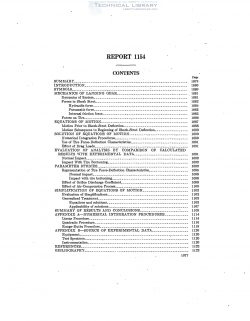naca-report-1154
- Version
- 275 Downloads
- 3.98 MB File Size
- 1 File Count
- October 27, 2016 Create Date
- October 27, 2016 Last Updated
National Advisory Committee for Aeronautics, Report - Analysis of Landing Gear Behavior

This report presents a theoretical study of the behavior of the
conventional type of oleo-pneumatic landing gear during the
process of landing impact. The basic analysis is presented in
a general form and treats the motions of the landing gear prior
to and subsequent to the beginning of shock—strut deflection. In
the analysis of the first phase of the impact the landing gear is
treated as a single-degree—of-freedom system in order to deter-
mine the conditions of motion at the instant of initial shock-strut
deflection, after which instant the landing gear is considered as
a system with two degrees of freedom. The equations for the
two-degree-of-freedom system consider such factors as the
hydraulic (velocity square) resistance of the orifice, the forces
due to air compression and internal friction in the shock strut,
the 'nonlin ear force-deflection characteristics of the tire, the wing
lift, the inclination of the landing gear, and the ejects of wheel
spinv/up drag loads.
The applicability of the analysis to actual landing gears has
been investigated for the particular case of a vertical landing
gear in the absence of drag loads by comparing calculated
results with experimental drop-test data for impacts with and
without tire bottoming. The calculated behavior of the landing
gear was found to be in good agreement with the drop—test data.
Studies have also been made to determine the ejects of varia-
tions in such parameters as the dynamic force-deflection
characteristics of the tire, the orifice discharge coejicient, and the
polytropic exponent for the air-compression process, which
might not be known accurately in practical design problems.
The study of the ejects of variations in the tire characteristics
indicates that in the case of a normal impact without tire
bottoming reasonable variations in the force-deflection character—
istics have only a relatively small eject on the calculated behavior
of the landing gear. Approximating the rather complicated
force—deflection characteristics of the actual tire by simplified
exponential or linear-segment variations appears to be adequate
for practical purposes. Tire hysteresis was found to be
relatively unimportant.
| File | Action |
|---|---|
| naca-report-1154 Analysis of Landing Gear Behavior.pdf | Download |

Comment On This Post